Ancillary Services Provided by Hybrid Residential Renewable Energy Systems through Thermal and Electrochemical Storage Systems
Abstract
1. Introduction
2. HRES Description
Thermal Model of Building and System
3. HRES Control Strategy
3.1. Heat Pump Model
3.2. Thermal Energy Storage System Model
3.3. Simulation Specifications
4. Analysis of Results
5. Conclusions
- The installation of a TES in the microgrid allows for cost savings up to 30% in the winter and give increased profits in the order of 5% in the summer.
- In the winter, a strong reduction of energy unbalance (in the order of 20%) has been achieved including a TES. In the summer, despite the overall unbalanced energy exchanged with the grid is lower for the “No TES” case, a greater value in terms of unexpected energy purchased is observed.
- In the winter, the TES leads to reduce the number of HP startups while decreasing the average load factor. The load factor trend is similar in the summer, while the number of HP startups is increased for the TES cases with respect to the cases without TES.
- Benefits in the stabilization of comfort conditions have also been achieved thanks to the TES. Room temperature has more stable profiles as standard deviation gets lower by a margin of 2% to 5%.
Author Contributions
Funding
Acknowledgments
Conflicts of Interest
Appendix A
Appendix B
- -
- COSMO-ME: equations integrated up to 72 h on a grid with a 5-km step and 45 vertical levels. It covers part of the central-southern Europe and the Mediterranean basin with four runs a day (00, 06, 12, and 18 UTC). The initial state is the result of the probabilistic data assimilation analysis performed by the COMET and the boundary conditions are defined by the European Center for Medium-Range Weather Forecast’s models.
- -
- COSMO-IT: equations integrated up to 30/48 h on a grid connected to COSMO-ME with a 2.2 km-step and 65 vertical levels. It covers Italy with four runs per day (00, 06, 12, and 18 UTC)) and uses as the initial state the fields of analysis produced by the very high resolution COMET assimilation system.
- -
- COSMO-ME EPS, consisting of 40 + 1 members integrated on a grid with a 7-km step and 45 vertical levels, covering central-southern Europe and the Mediterranean basin, with two runs per day (00 and 12 UTC), for forecasts up to 72 h.
- -
- COSMO-IT EPS (pre-operational), consisting of 20 + 1 integrated members on a grid with a 2.2 km and 65 vertical steps, covering Italy, with two runs per day (00 and 12 UTC), for forecasts up to 48 h.
References
- Eurostat, Consumption of Energy, Statistics Explained Website, Data extracted in June 2017. Available online: http://ec.europa.eu/eurostat/statistics-explained/index.php/Consumption_of_energy (accessed on 1 March 2019).
- Energy Consumption in Households. Available online: https://ec.europa.eu/eurostat/statistics-explained/index.php?title=Energy_consumption_in_households (accessed on 1 March 2019).
- European Parliament and Council. Directive 2010/31/EU on the Energy Performance of Buildings; European Parliament and Council: Brussels, Belgium, 2010. [Google Scholar]
- Kim, N.K.; Shim, M.H.; Won, D. Building Energy Management Strategy Using an HVAC System and Energy Storage System. Energies 2018, 11, 2690. [Google Scholar] [CrossRef]
- Hafeez, G.; Javaid, N.; Iqbal, S.; Khan, F.A. Optimal Residential Load Scheduling Under Utility and Rooftop Photovoltaic Units. Energies 2018, 11, 611. [Google Scholar] [CrossRef]
- Javaid, N.; Ahmed, F.; Ullah, I.; Abid, S.; Abdul, W.; Alamri, A.; Almogren, A.S. Towards Cost and Comfort Based Hybrid Optimization for Residential Load Scheduling in a Smart Grid. Energies 2017, 10, 1546. [Google Scholar] [CrossRef]
- Aslam, S.; Iqbal, Z.; Javaid, N.; Khan, Z.A.; Aurangzeb, K.; Haider, S.I. Towards Efficient Energy Management of Smart Buildings Exploiting Heuristic Optimization with Real Time and Critical Peak Pricing Schemes. Energies 2017, 10, 2065. [Google Scholar] [CrossRef]
- Iqbal, Z.; Javaid, N.; Mohsin, S.M.; Akber, S.M.A.; Afzal, M.K.; Ishmanov, F. Performance Analysis of Hybridization of Heuristic Techniques for Residential Load Scheduling. Energies 2018, 11, 286. [Google Scholar] [CrossRef]
- Park, L.; Jang, Y.; Bae, H.; Lee, J.; Park, C.Y.; Cho, S. Automated Energy Scheduling Algorithms for Residential Demand Response Systems. Energies 2017, 10, 1326. [Google Scholar] [CrossRef]
- He, M.F.; Zhang, F.X.; Huang, Y.; Chen, J.; Wang, J.; Wang, R. A distributed demand side management algorithm for smart grid. Energies 2019, 12, 426. [Google Scholar] [CrossRef]
- Lemus, F.D.S.; Minor Popocatl, O.; Aguilar Mejia, R. Tapia Olvera, Optimal Economic Dispatch in Microgrids with Renewable Energy Sources. Energies 2019, 12, 181. [Google Scholar] [CrossRef]
- Ruiz, G.R.; Segarra, E.L.; Bandera, C.F. Model Predictive Control Optimization via Genetic Algorithm Using a Detailed Building Energy Model. Energies 2019, 12, 34. [Google Scholar] [CrossRef]
- Kontes, G.D.; Giannakis, G.I.; Sanchez, V.; de Augustin Chamacho, P.; Romero Amortrortu, A.; Panagiotidou, N.; Rovas, D.V.; Steiger, S.; Mutschler, C.; Gruen, G. Simulation-Based Evaluation and Optimization of Control Strategies in Buildings. Energies 2018, 11, 3376. [Google Scholar] [CrossRef]
- Barata, F.; Igreja, J. Energy Management in Buildings with Intermittent and Limited Renewable Resources. Energies 2018, 11, 2748. [Google Scholar] [CrossRef]
- Izawa, A.; Fripp, M. Multi-Objective Control of Air Conditioning Improves Cost, Comfort and System Energy Balance. Energies 2018, 11, 2373. [Google Scholar] [CrossRef]
- Jin, D.; Christopher, W.; James, N.; Teja, K. Occupancy-Based HVAC Control with Short-Term Occupancy Prediction Algorithms for Energy-Efficient Buildings. Energies 2018, 11, 2427. [Google Scholar]
- Serale, G.; Fiorentini, M.; Capozzoli, A.; Bernardini, D.; Bemporad, A. Model Predictive Control (MPC) for Enhancing Building and HVAC System Energy Efficiency: Problem Formulation, Applications and Opportunities. Energies 2018, 11, 631. [Google Scholar] [CrossRef]
- Robillart, M.; Schalbart, P.; Chaplais, F.; Peuportier, B. Model reduction and model predictive control of energy-efficient buildings for electrical heating load shifting. J. Process. Control. 2018, 74, 23–34. [Google Scholar] [CrossRef]
- Bruni, G.; Cordiner, S.; Mulone, V.; Rocco, V.; Spagnolo, F. A study on the energy management in domestic micro-grids based on Model Predictive Control strategies. Energy Convers. Manag. 2015, 102, 50–58. [Google Scholar] [CrossRef]
- Killian, M.; Zauner, M.; Kozek, M. Comprehensive smart home energy management system using mixed-integer quadratic-programming. Appl. Energy 2018, 222, 662–672. [Google Scholar] [CrossRef]
- D’Ettorre, F.; de Rosa, M.; Conti, P.; Schito, E.; Testi, D.; Finn, D.P. Economic assessment of flexibility offered by an optimally controlled hybrid heat pump generator: A case study for residential building. Energy Procedia 2018, 148, 1222–1229. [Google Scholar] [CrossRef]
- di Perna, C.; Magri, G.; Giuliani, G.; Serenelli, G. Experimental assessment and dynamic analysis of a hybrid generator composed of an air source heat pump coupled with a condensing gas boiler in a residential building. Appl. Therm. Eng. 2015, 76, 86–97. [Google Scholar] [CrossRef]
- Klein, K.; Huchtemann, K.; Müller, D. Numerical study on hybrid heat pump systems in existing buildings. Energy Build. 2014, 69, 193–201. [Google Scholar] [CrossRef]
- Bagarella, G.; Lazzarin, R.; Noro, M. Annual simulation, energy and economic analysis of hybrid heat pump systems for residential buildings. Appl. Therm. Eng. 2016, 99, 485–494. [Google Scholar] [CrossRef]
- D’Ettorre, F.; Conti, P.; Schito, E.; Testi, D. Model predictive control of a hybrid heat pump system and impact of the prediction horizon on cost-saving potential and optimal storage capacity. Appl. Therm. Eng. 2019, 148, 524–535. [Google Scholar] [CrossRef]
- Mohammadi, S.; Mohammadi, A. Stochastic scenario-based model and investigating size of battery energy storage and thermal energy storage for micro-grid. Int. J. Electr. Power Energy Syst. 2014, 61, 531–546. [Google Scholar] [CrossRef]
- Nguyen, D.T.; Le, L.B. Optimal Bidding Strategy for Microgrids Considering Renewable Energy and Building Thermal Dynamics. IEEE Trans. Smart Grid 2014, 5, 1608–1620. [Google Scholar] [CrossRef]
- Korkas, C.D.; Baldi, S.; Michailidis, I.; Kosmatopoulos, E.B. Occupancy-based demand response and thermal comfort optimization in microgrids with renewable energy sources and energy storage. Appl. Energy 2016, 163, 93–104. [Google Scholar] [CrossRef]
- Comodi, G.; Giantomassi, A.; Severini, M.; Squartini, S.; Ferracuti, F.; Fonti, A.; Cesarini, D.N.; Morodo, M.; Polonara, F. Multi-apartment residential microgrid with electrical and thermal storage devices: Experimental analysis and simulation of energy management strategies. Appl. Energy 2015, 137, 854–866. [Google Scholar] [CrossRef]
- Bartolucci, L.; Cordiner, S.; Mulone, V.; Santarelli, M. Short-therm forecasting method to improve the performance of a model predictive control strategy for a residential hybrid renewable energy system. Energy 2019, 172, 997–1004. [Google Scholar] [CrossRef]
- Gelleschus, R.; Böttiger, M.; Stange, P.; Bocklisch, T. Comparison of optimization solvers in the model predictive control of a PV-battery-heat pump system. Energy Procedia 2018, 155, 524–535. [Google Scholar] [CrossRef]
- Bartolucci, L.; Cordiner, S.; Mulone, V.; Rocco, V.; Rossi, J.L. Renewable source penetration and microgrids: Effects of MILP–Based control strategies. Energy 2018, 152, 416–426. [Google Scholar] [CrossRef]
- ELFOEnergy Extended Inverter, SERIE WSAN-XIN 81-171. Available online: http://portal.clivet.it/products/app.jsp# (accessed on 1 March 2019).
- Available online: http://www.meteoam.it/ta/previsione/482/ROMA (accessed on 1 March 2019).
- Sousa, T.; Morais, H.; Castro, R.; Vale, Z. Evaluation of different initial solution algorithms to be used in the heuristics optimization to solve the energy resources scheduling in smart grid. Appl. Soft Comput. 2016, 48, 491–506. [Google Scholar] [CrossRef]
- Verhelst, C.; Logist, F.; Impe, J.V.; Helsen, L. Study of the optimal control problem formulation for modulating air-to-water heat pumps connected to a residential floor heating system. Energy Build. 2012, 45, 43–53. [Google Scholar] [CrossRef]
- Available online: http://www.meteoam.it/page/verifiche-modelli (accessed on 1 March 2019).
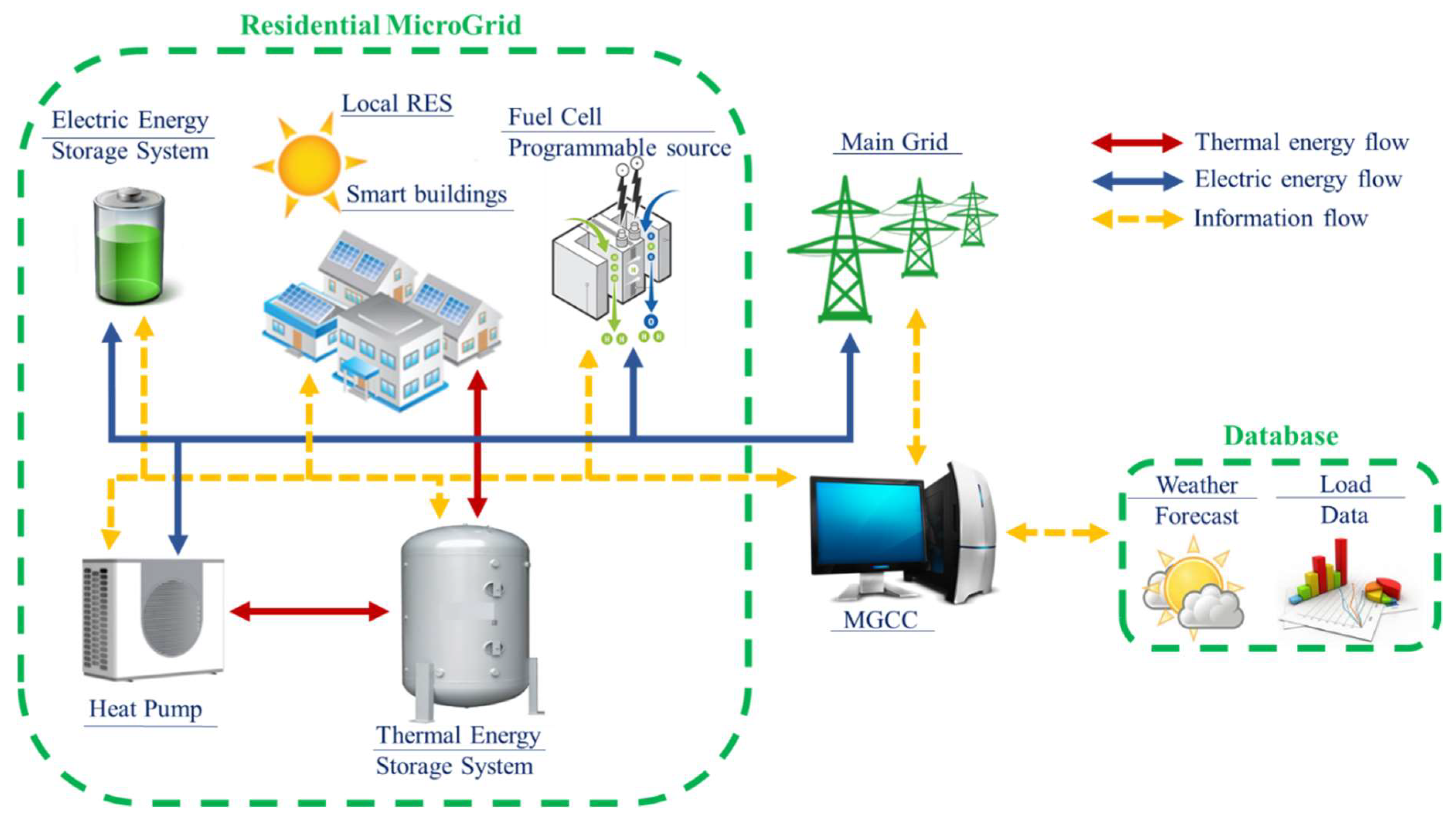
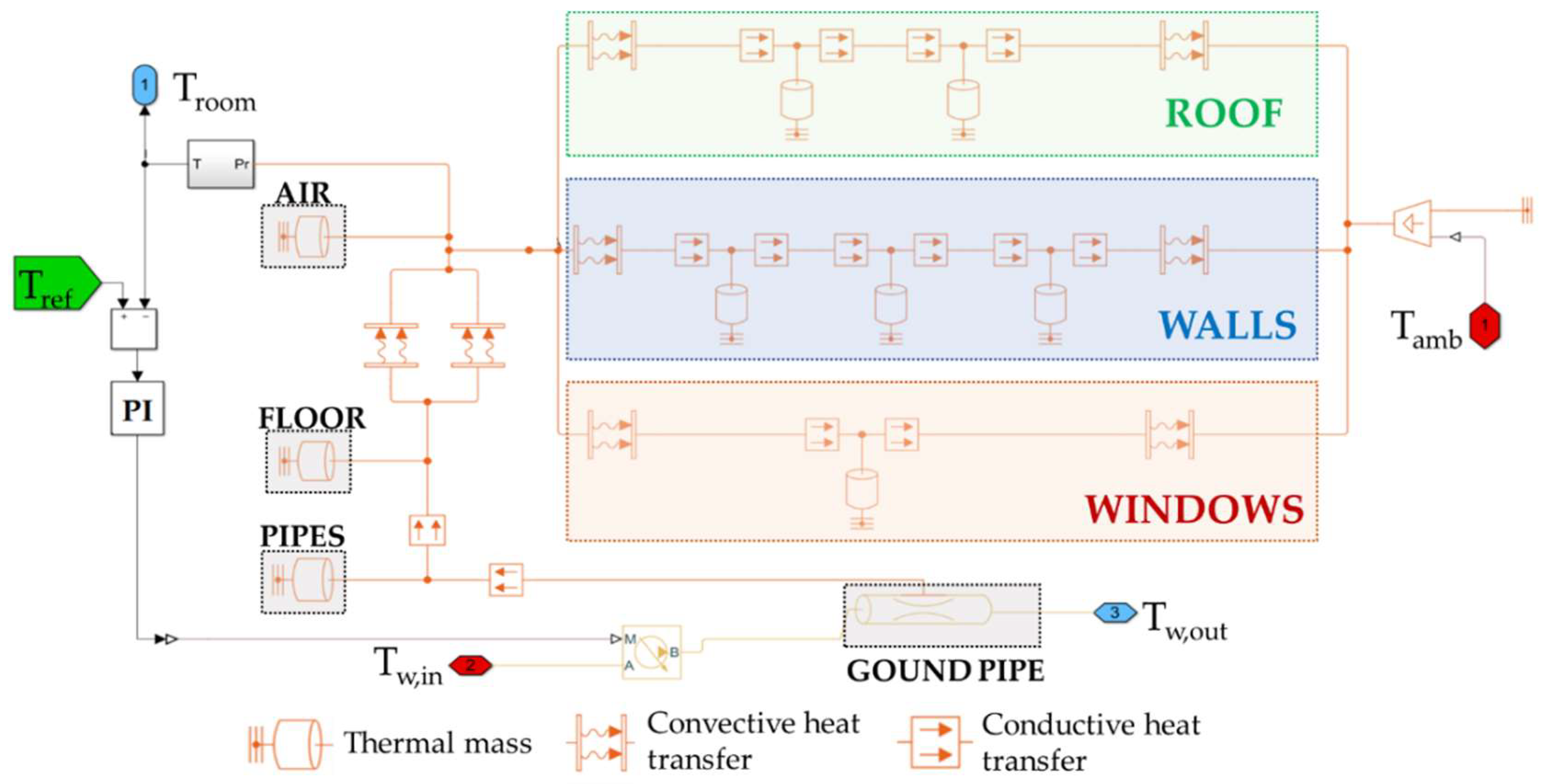
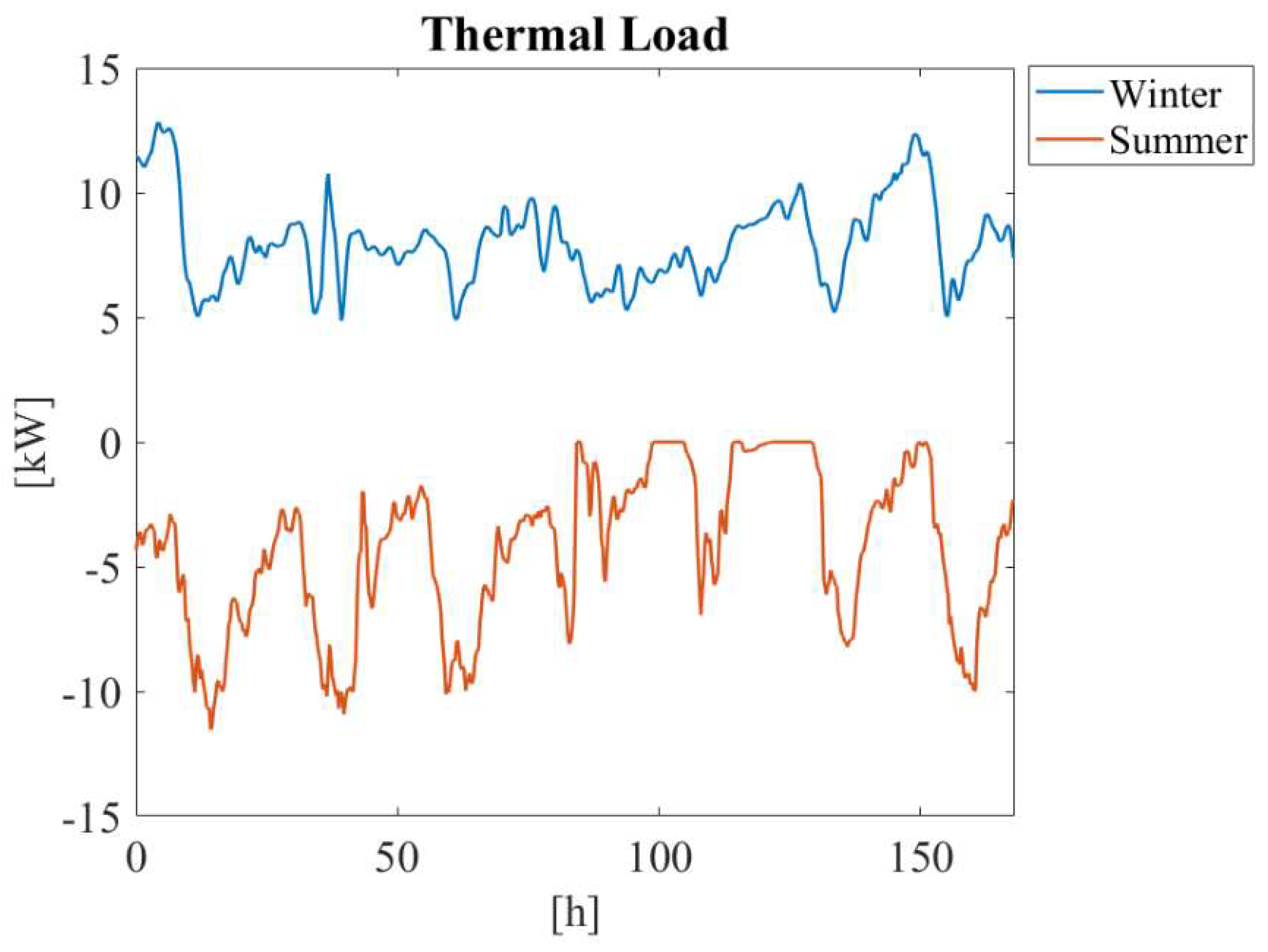
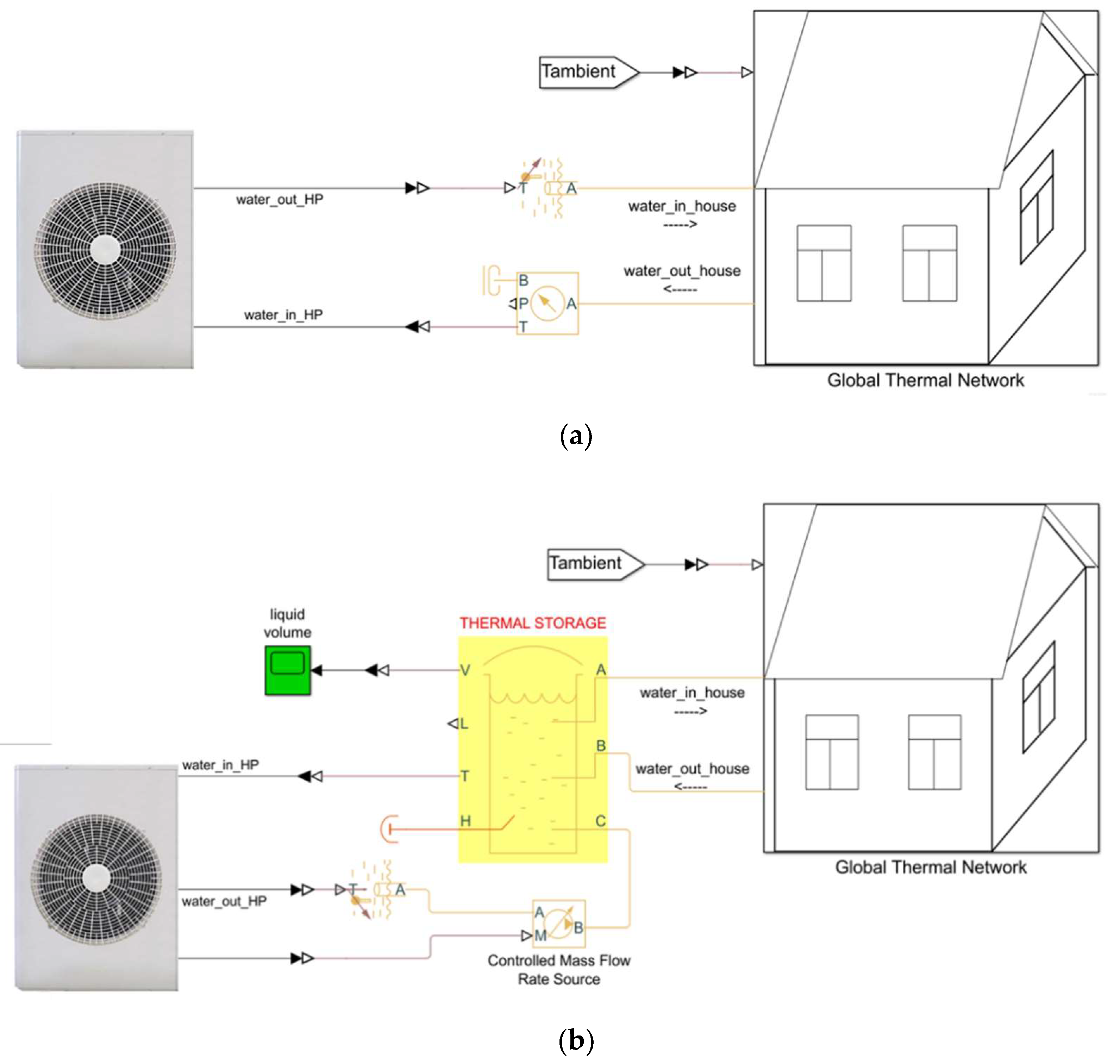
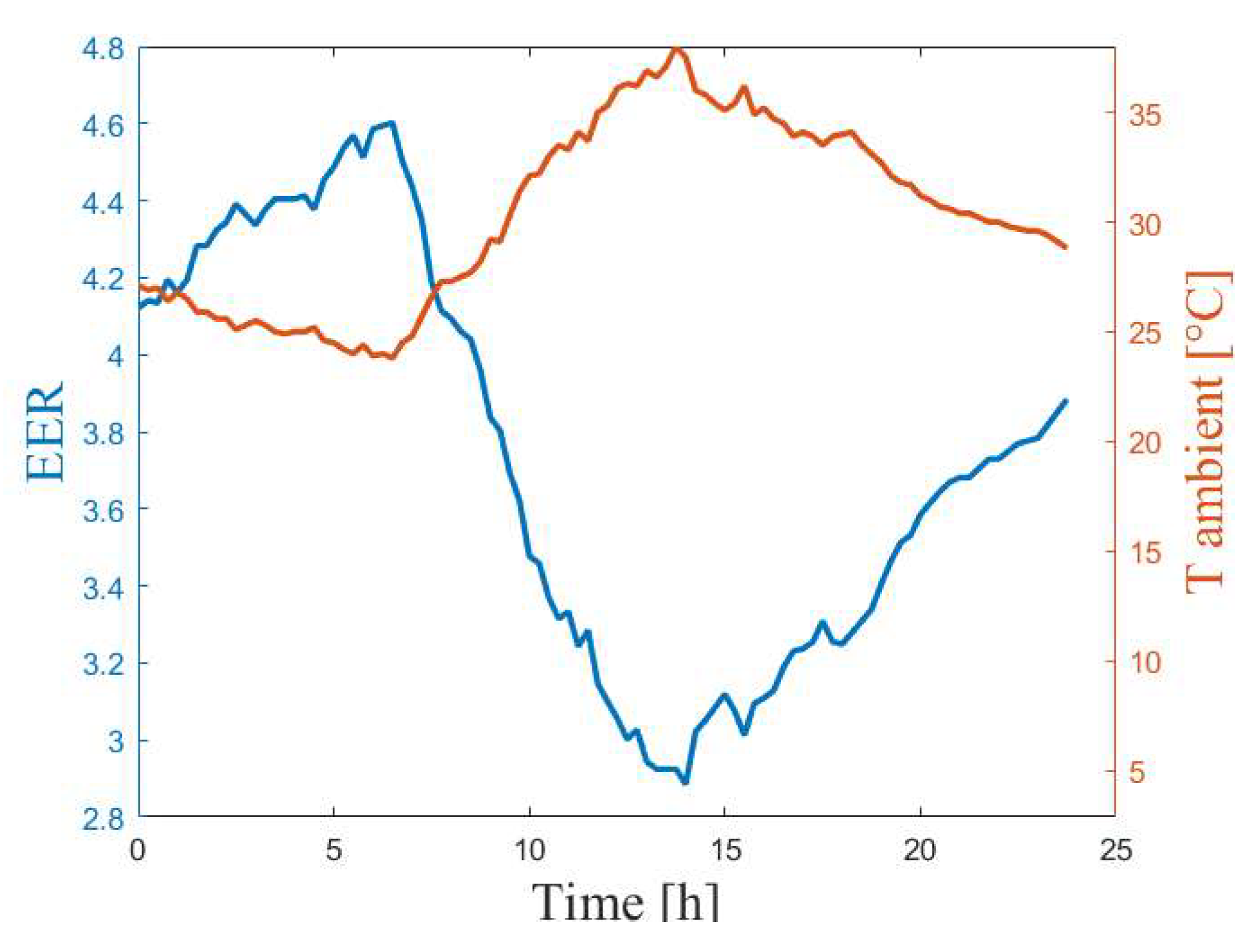
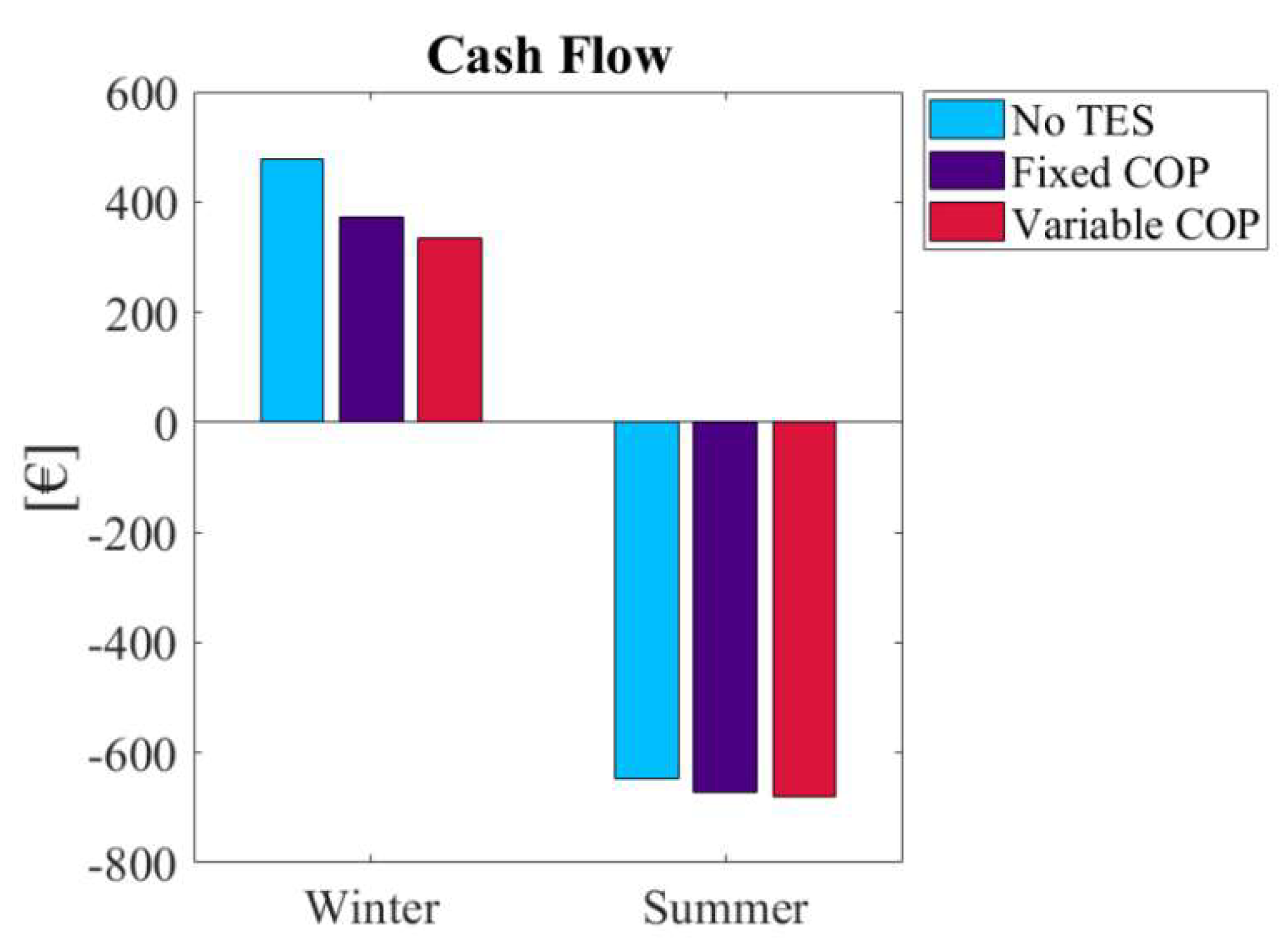
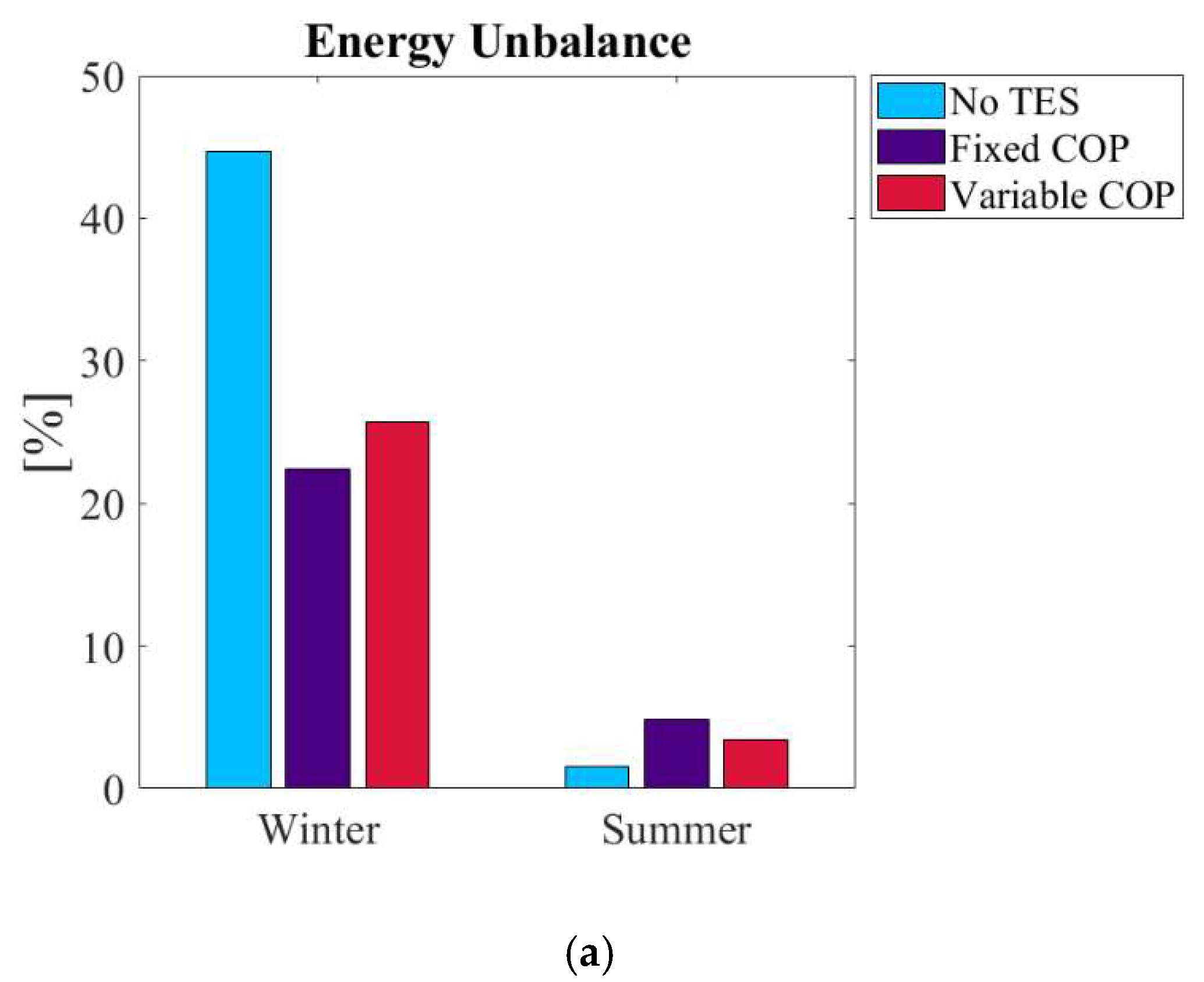
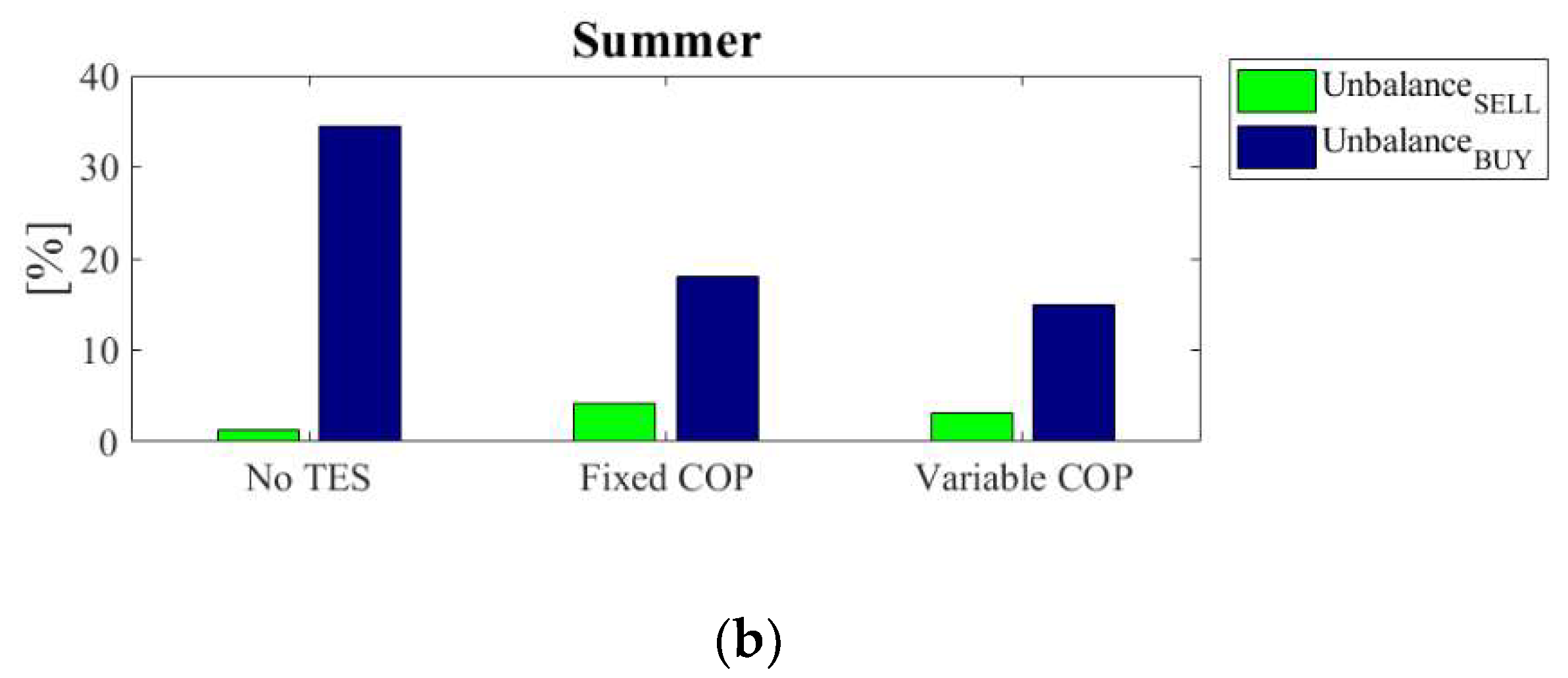
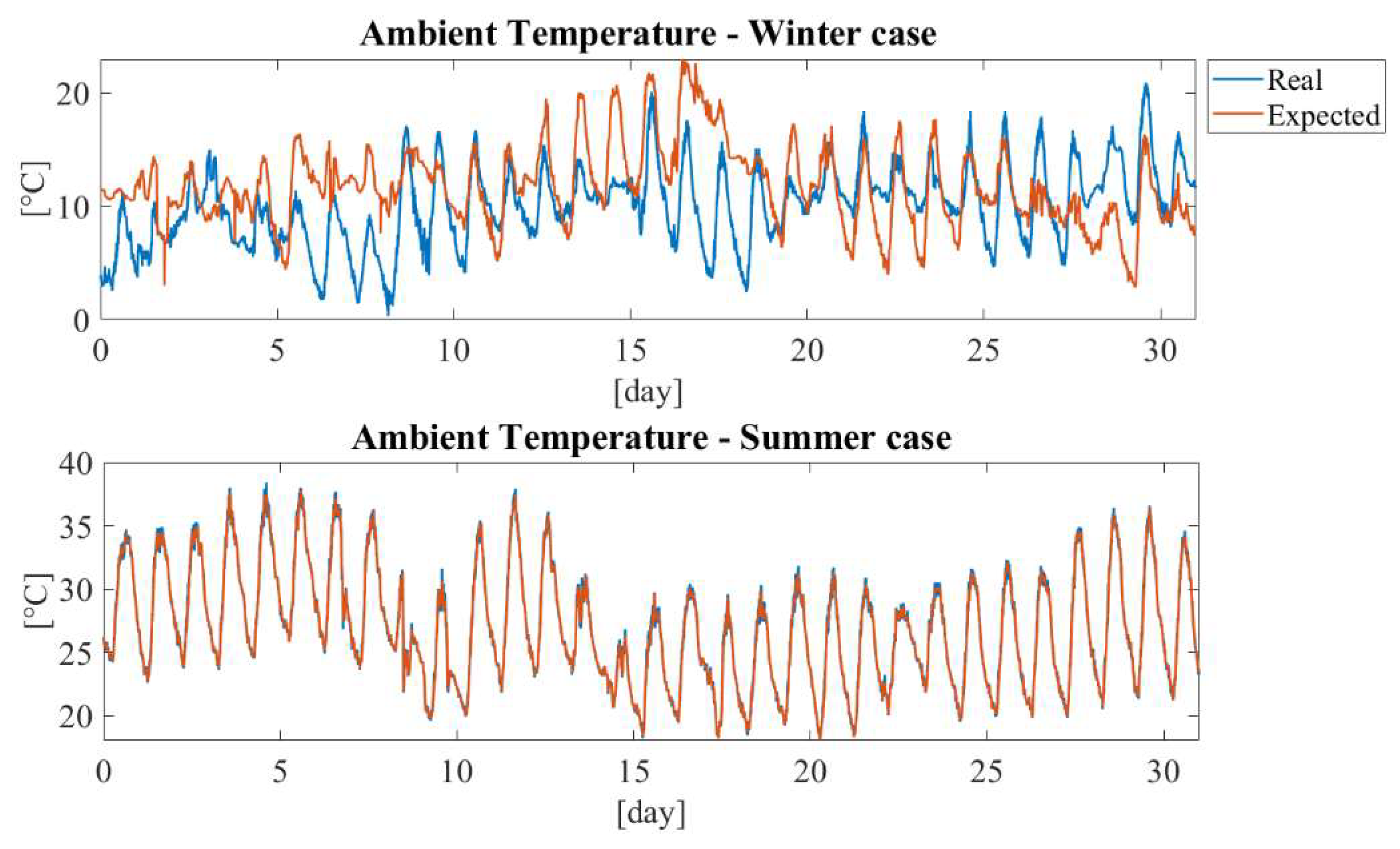
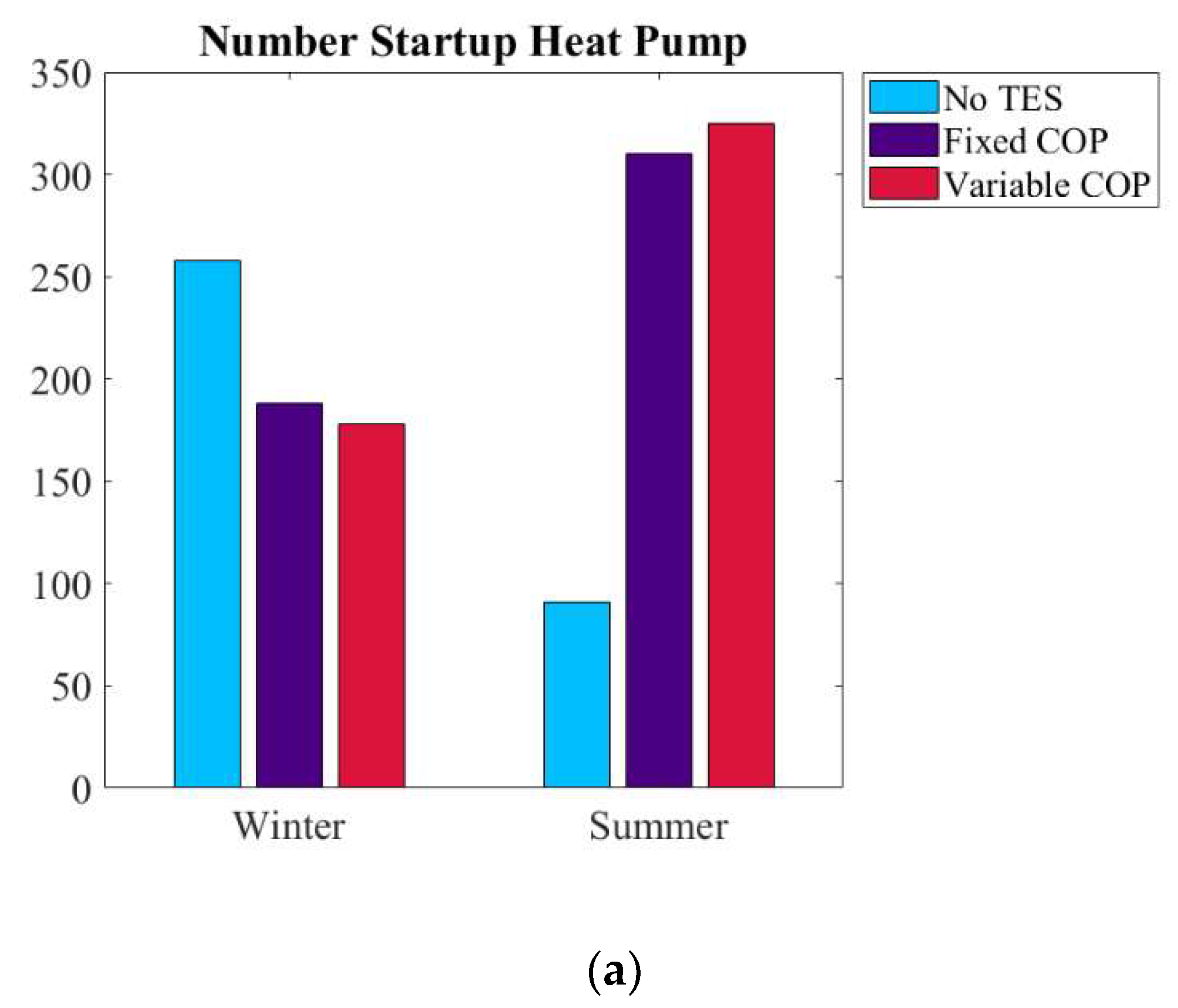
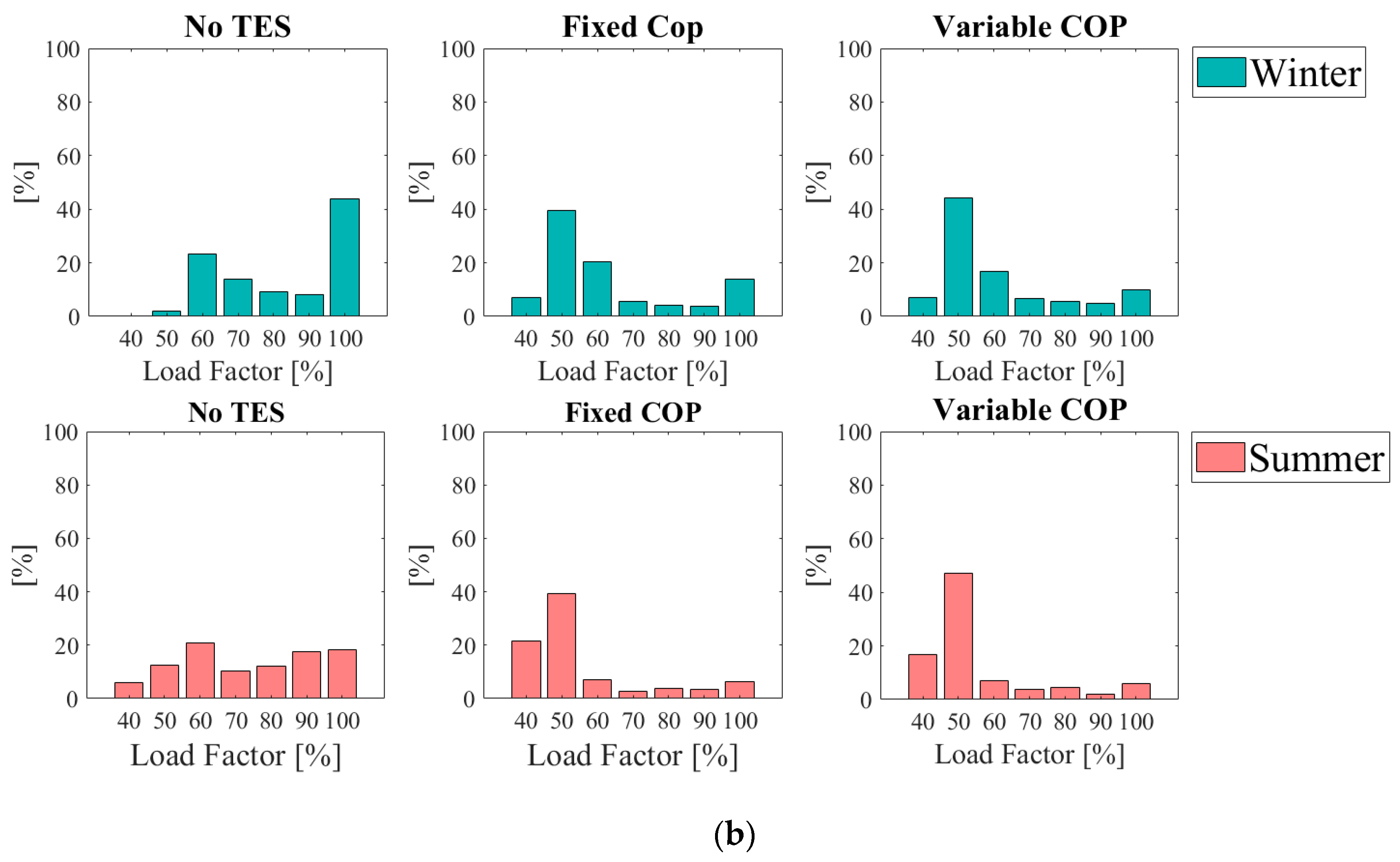
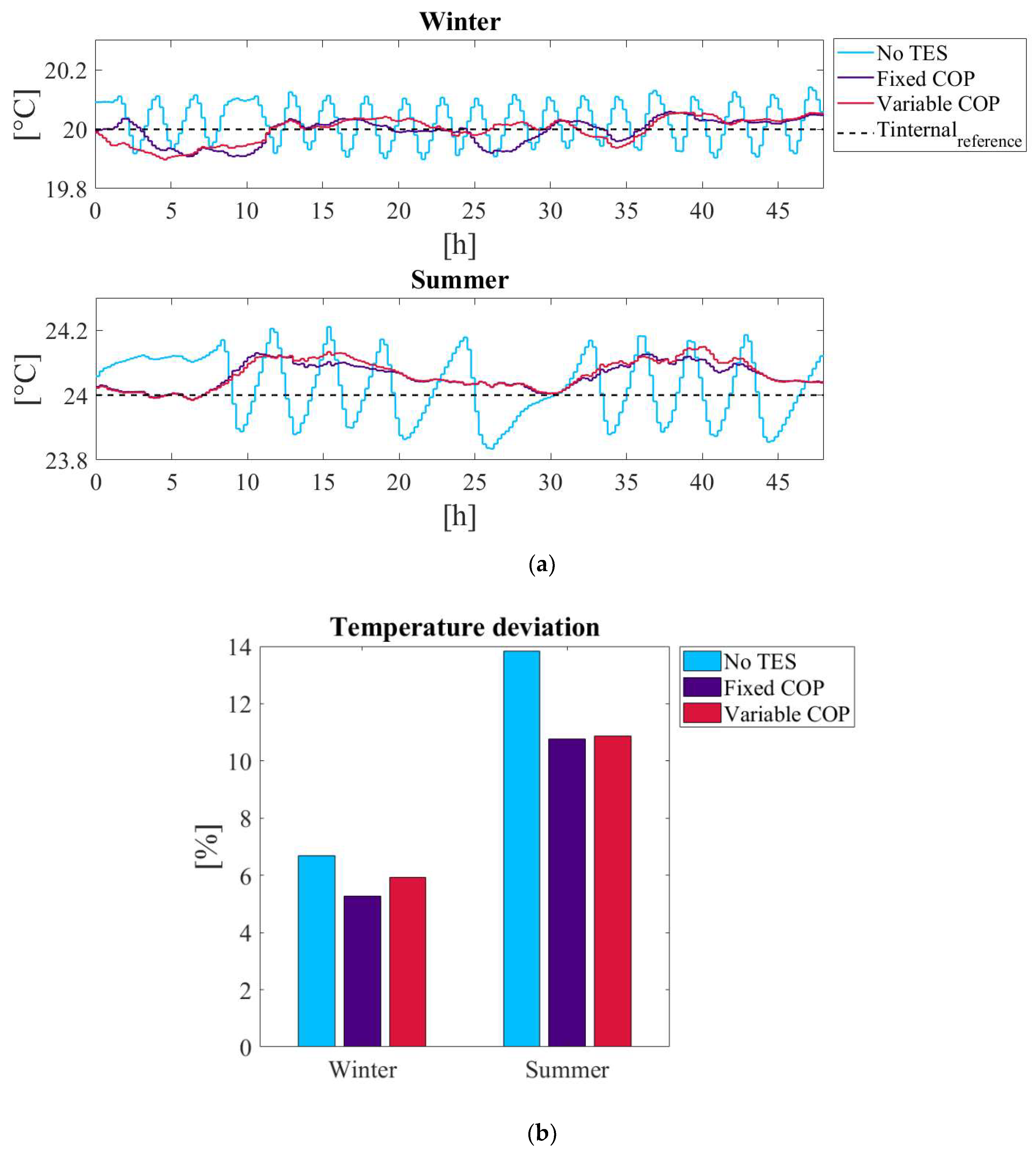
| Heating | Cooling | ||
|---|---|---|---|
| Tamb (°C) | COP | Tamb (°C) | EER |
| −10/−10.5 | 1.98 | 20 | 5.23 |
| −7/−8 | 2.13 | 25 | 4.40 |
| 0/−0.6 | 2.47 | 30 | 3.73 |
| 2/1.1 | 2.59 | 35 | 3.13 |
| 7/6 | 3.23 | 40 | 2.64 |
| 10/8.2 | 3.40 | 45 | 2.30 |
| 15/13 | 3.84 | ||
| 18/14 | 3.81 | ||
| Season | Test Case | Grid Sold (€) | Grid Bought (€) | Battery (€) | Fuel Cell (€) |
|---|---|---|---|---|---|
| Winter | |||||
| No TES | −5.6 | 206.8 | 49.4 | 227.6 | |
| Fixed COP | −6.8 | 238.8 | 42.3 | 96.9 | |
| Variable COP | −19.1 | 220.7 | 42 | 91.1 | |
| Summer | |||||
| No TES | −722.4 | 2.1 | 58 | 15.7 | |
| Fixed COP | −749.5 | 15.4 | 52.2 | 9.8 | |
| Variable COP | −750.8 | 7 | 52.8 | 10.3 |
| Season | Test Case | Energy Sold (kWh) | Energy Purchased (kWh) |
|---|---|---|---|
| Winter | |||
| No TES | 24.5 | 2405.5 | |
| Fixed COP | 32.2 | 2772 | |
| Variable COP | 90.8 | 2563.6 | |
| Summer | |||
| No TES | 3441.4 | 23.9 | |
| Fixed COP | 3571.1 | 180.5 | |
| Variable COP | 3578.1 | 81.9 |
© 2019 by the authors. Licensee MDPI, Basel, Switzerland. This article is an open access article distributed under the terms and conditions of the Creative Commons Attribution (CC BY) license (http://creativecommons.org/licenses/by/4.0/).
Share and Cite
Bartolucci, L.; Cordiner, S.; Mulone, V.; Santarelli, M. Ancillary Services Provided by Hybrid Residential Renewable Energy Systems through Thermal and Electrochemical Storage Systems. Energies 2019, 12, 2429. https://doi.org/10.3390/en12122429
Bartolucci L, Cordiner S, Mulone V, Santarelli M. Ancillary Services Provided by Hybrid Residential Renewable Energy Systems through Thermal and Electrochemical Storage Systems. Energies. 2019; 12(12):2429. https://doi.org/10.3390/en12122429
Chicago/Turabian StyleBartolucci, Lorenzo, Stefano Cordiner, Vincenzo Mulone, and Marina Santarelli. 2019. "Ancillary Services Provided by Hybrid Residential Renewable Energy Systems through Thermal and Electrochemical Storage Systems" Energies 12, no. 12: 2429. https://doi.org/10.3390/en12122429
APA StyleBartolucci, L., Cordiner, S., Mulone, V., & Santarelli, M. (2019). Ancillary Services Provided by Hybrid Residential Renewable Energy Systems through Thermal and Electrochemical Storage Systems. Energies, 12(12), 2429. https://doi.org/10.3390/en12122429





